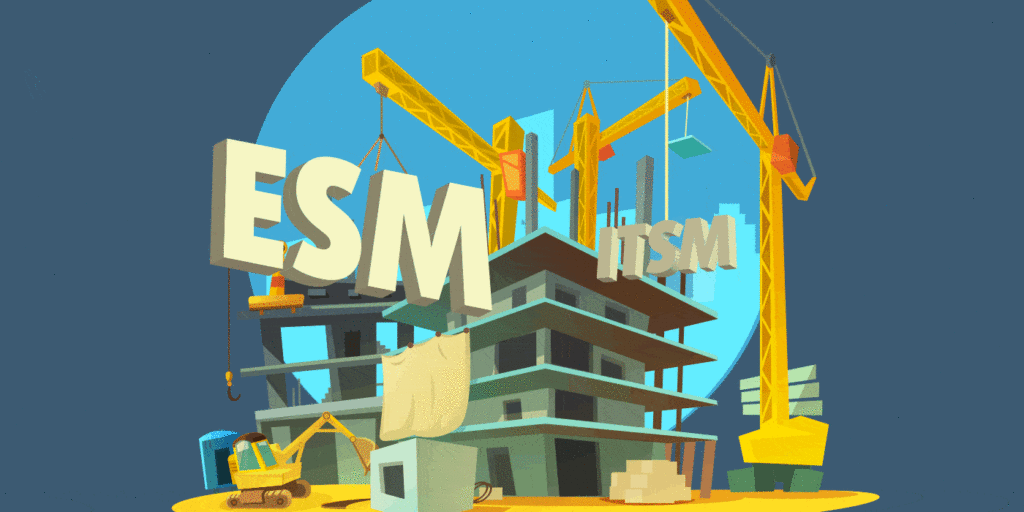Let’s talk about ITSM moving beyond IT to ESM. The capabilities that are collectively known as IT service management (ITSM) have traditionally only been seen as “something that’s only applicable to IT.” Or, for those with a narrower perspective of ITSM, “something that’s only applicable to the “help desk.” Recently though, the ITSM – or service management – conversation has changed. And it continues to change rapidly, especially in terms of enterprise service management (ESM).
The Changing ITSM Landscape
There’s just so much going on in ITSM right now. For example:
- The rise in interest and adoption of other IT management approaches such as Lean, DevOps, Kanban, Agile, and others.
- Changes in the ITSM best practice space – there was the publication of VeriSM, the first refresh of ITIL since 2011, along with other bodies of best practice such as IT4IT being promoted more.
- ITSM tool capabilities have advanced on the back of the demand for more consumerized capabilities – from the ease of use to modern access and communication channels such as self-service and chat.
- Newer technologies and use cases such as artificial intelligence (AI), machine learning, chatbots, and robotic process automation (RPA), plus digital transformation have brought with them operational efficiencies and an even more compelling ITSM proposition.
But perhaps one of the highest-profile changes is the speed with which ITSM is moving beyond IT to ESM.
The Rise of ESM and the customer experience (CX)
ITSM – in the form of ESM – is rapidly expanding into other parts of the enterprise, as savvy organizations build on the fact that defined processes and services, with technological enablement, can improve productivity and deliver better outcomes.
Thus, ITSM is mutating – with it no longer viewed as a single-track approach and organizations who can see the pan-enterprise opportunity embracing what ESM can do across different business functions such as human resources (HR), facilities, legal, marketing, etc.
Plus, the focus of ITSM and ESM is moving from the services to the customer and CX in particular.
Such that while ITSM – and now ESM – has always been delivering quality services and support (by way of fit-for-purpose reliability, continuity, availability, capacity, and security). It’s now inverting itself from being inwardly-focused to outwardly-focused with an emphasis on the CX (and employee experience).
Moving beyond IT to ESM: Much of the ITSM best practice holds true
While all this ITSM change is in full flow, and people might be excited by the “new stuff,” the ITSM fundamentals should not be overlooked.
Good ITSM – and thus ESM – needs a well-thought-out strategy (that aligns with the overall business strategy). Coupled with, and enabled, by a suitable governance approach.
In IT terms, COBIT has traditionally been employed to consider governance needs from an organizational perspective, and to avoid IT governance and enterprise governance being treated as two discreet, and potentially disconnected, entities. The applicability is there from an ESM perspective too.
The new world of service management: moving beyond IT to ESM
In one of my previous articles – Why ITSM is More Important Now Than Ever Before – I talked to the new realities of modern-day ITSM, including:
- Business and IT convergence
- Ecosystems of components, partners, and suppliers found both internally and externally
- A business value and outcome focus
- Business initiatives enabled by IT
- A robust set of capabilities and tools
The adoption of ITSM is a key way in which IT organizations can deliver greater value, become agile and more responsive to the ever-changing business needs, and lead the entire company into digital transformation (in part because ESM is really technology-enabled back-office transformation). But it’s more than just this as we enter a new world of service management.
Progressive corporate IT organizations will move to be value enablers rather than commodity suppliers. Because businesses need good IT, with this acting as the critical conduit between the business and its customers. And the effective use of IT, and ITSM, will play a big part in how customers perceive the business, it will influence engagement, and will ultimately impact spend and the ongoing profitability of that business.
How to help maximize business value when moving beyond IT to ESM
So, what does an IT organization need to do to be successful in delivering ESM and increased business value?
Here are three good places to start:
- Learn the business of the business (from the business).There’s a need to become fully versed in what the business is all about – because trying to deliver new technical capabilities without knowing how they need to benefit the business is going to be hard at best and more likely a missed opportunity and wasted resource. It’s imperative to understand how technology will lead to business success.
- Change to a stance of “lead and collaborate,” rather than “follow and react.”The IT organization can no longer afford to wait for business needs to come to it. So, get involved, even immersed, in business forums. For instance, attend business-function team meetings or review business planning and strategy meeting minutes to understand the challenges and opportunities being faced (both now and in the future). Then proactively propose how IT will help transform business strategies into realities.
- Rise above the technology.Think about technology solutions to business problems. Talk in business terms. And translate technical terms to business language (and vice versa) in order to think and converse at a business, rather than technology, level.
There’s no doubt that these are exciting times for ITSM professionals, and it’s important that we realize that there is a need to change as part of the change happening around us. With it important to avoid being a spectator and to become part of the business conversations that allow IT to be a driver and co-creator of business value – with ITSM moving beyond IT to ESM being a key opportunity.
Want more on ESM?
Sarah Lahav
As SysAid Technologies' first employee, Sarah Lahav has remained the vital link between SysAid and its customers since 2003. She is the current CEO and former VP of Customer Relations at SysAid, two positions that have given her a hands-on role in evolving SysAid solutions to align with the dynamic needs of service managers.


3 Responses
Great article and enjoyed reading this. One thing you said that I feel is so important “the focus of ITSM and ESM is moving from the services to the customer and CX in particular” – I would actually go as far as saying “to survive IT organisations and their associated ITSM functions must have laser focus on CX” after all the customer is the only reason for their existence.
A very important perspective you gave, Sarah. I believe that the fundamentals of ITSM are applicable in other domains and that the value a service provider provides to their customer needs to meet their expectations for it to be worthwhile.
Quite an informative read on the why and what of IT Service Management and Enterprise Service Management…